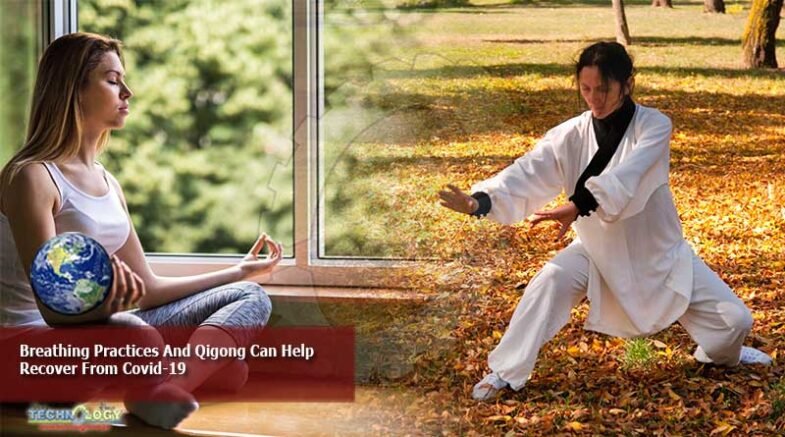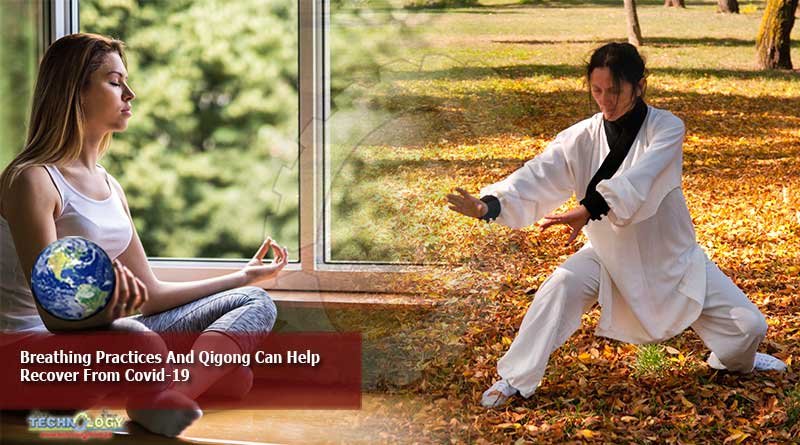Two integrative medicine physicians explain the benefits of breathing practices and qigong

When examining a patient for Covid-19, we always ask about the breath. “Is it short?” “Does your chest feel tight?” “Let’s measure your oxygen saturation.” What if a secret to recovery from the virus was in the breath as well?
At the University of Arizona Andrew Weil Center for Integrative Medicine, we have been researching which evidence-based modalities may support recovery from Covid-19. As Covid-19 research is still in the early stages, we have also examined what modalities have demonstrated improvement in lung function in lung diseases with similar pathologies.
While long-term consequences of Covid-19 are still being elucidated, the concern about development of pulmonary fibrosis in patients recovering from Covid-19 is rising. This concern stems from the development of lung fibrosis seen in patients after the SARS coronavirus outbreak in 2003.
Pulmonary fibrosis is scar tissue that forms in a patient’s lungs, reducing flexibility and movement and the ability to oxygenate blood. A regular practice of breathing intentionally can reverse this tendency through increased lung expansion and strengthened respiratory muscles, both of which contribute to increased ventilation (the lung’s capacity to provide oxygen). Which patients will develop lung fibrosis after Covid-19 and which will recover without fibrosis is unknown at this point, so practices to aid lung recovery are a smart idea for everyone.
Diaphragmatic breathing is a good place to start. In this practice, also called belly breathing, you slow and deepen your breathing by fully expanding your abdomen. This breath is most easily learned laying down, but it can be done in any position. To give it a try, place one hand on your stomach and the other on your chest. Begin breathing deeply into the belly region so that your hand rises as the belly fills with air. Ideally, the hand on your chest remains still. Now flex your abdominal muscles and exhale slowly and fully; notice that your belly fall back toward the spine while your chest remains relatively still. If you purse your lips as you exhale, this slows the breath even more; this is sometimes called pursed-lip breathing.
There is evidence to suggest diaphragmatic breathing, pursed-lip breathing, and yoga breathing are all viable techniques for improving lung function. All three have been shown to improve breathing capacity in pulmonary fibrosis patients and the ability to walk longer distances in people with chronic obstructive pulmonary disease (COPD). Covid-19 recovery recommendations developed by rehabilitation experts at Loma Linda University in California include these breathing exercises. They suggest people recovering from Covid-19 begin breath work as soon as they no longer require oxygen or their severe shortness of breath has improved.
One breathing practice popularized by Dr. Andrew Weil is called the 4-7-8 breath. This practice originated as a yoga breathing practice. In addition to slowing and deepening the breath, it helps reduce stress. In Weil’s words, “This is the most powerful relaxation technique I know. It takes little time, requires no equipment, costs nothing. You must practice it twice a day. With practice, it lowers heart rate and blood pressure, improves GI function, promotes good sleep, and counteracts anxiety.” The 4-7-8 breath can even be practiced by someone on oxygen therapy. This breath is effective even for COPD patients with extreme shortness of breath and oxygen dependence and can be learned in a few minutes.
Canadian researchers recently issued breathing exercises for Covid-19 recovery and suggest they should be practiced one to three times a day for up to 10 minutes each time. Singing is considered another form of effective breath work and is recommended by doctors in the U.K. Singing for Lung Health programs are offered across the U.K. for lung health and have also been shown to improve mood.
In China, the potential therapeutic benefit of qigong in people recovering from Covid-19 is already under review.
One incredibly useful practice that may prove therapeutic for recovering Covid-19 patients is qigong. Qigong originated in China more than 4,000 years ago and is a mainstay of traditional Chinese medicine. Like yoga or tai chi, it is a practice of synchronizing breath with movement. Qigong translates to “life energy mastery” and includes exercise, movement of qi ( energy), and improved blood and lymphatic flow.
Research suggests that qigong improves health by decreasing stress, reducing inflammation, strengthening respiratory muscles, increasing lung capacity, and improving immune function. Each of these mechanisms can help restore lung function after Covid-19 infection.
Years prior to the coronavirus pandemic, a study of Japanese women in their sixties who were prescribed a daily 20-minute qigong routine (as well as exercising together once a week) yielded notable results. At the end of 12 weeks, the women had increased lung capacity and walking speeds. Qigong has been shown to improve lung function as measured through the amount of air inhaled in one minute or forcibly exhaled. It has also been shown to improve the distance a person (if practicing regularly) can walk in six minutes.
In China, the potential therapeutic benefit of qigong in people recovering from Covid-19 is already under review. One such small six-week feasibility study on 20 recovering Covid-19 patients provided 12-minute videos for practice at home. All participants who completed the exercises reported such a significant decrease in shortness of breath and increased physical ability and quality of life that they continued to perform the exercises twice daily after the study was over.
Qigong is, in part, such a promising convalescence therapy because it is so readily available. Qigong exercises can be done in as little as five minutes. Practicing one to three times per day is optimal. The form that qigong masters recommend for lung recovery entails tapping the chest to stimulate blood flow and energy flow and uses movements to expand the ribs and chest. This form of qigong is similar to the lung physiotherapy used by physiotherapists for recovery from lung infections and is recommended for Covid-19 recovery.
Finally, it is important to mention the unspoken fear that the experience of the pandemic carries with it. The physiological experience of fear is detrimental to well-being. Feelings of fear cause us to breathe faster and feel short of breath and can even prevent our lungs from fully inflating. Therefore, even those of us who are perfectly healthy may benefit from practicing intentional breathing and qigong exercises as we all navigate life in a pandemic.
The article is originally published at elemental.
